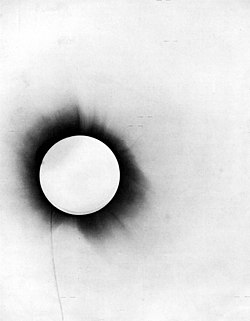Well, only four weeks and change behind us in this course, and… the class (see here and here) is ready to understand this wonderful equation:

and all that it implies. What is it? It encodes the shape of spacetime around a spherical blob of mass of total mass M. No, don’t worry too much about the details, since this is not a lecture about General Relativity….. it is just nice (I hope) every now and again to get a look at the sorts of things we use in our day to day work. This “warped” spacetime encodes what we interpret as the gravitational field (in the old Newtonian language) due to a spherical (or, to a good approximation, almost spherical) mass. Like the sun, or the earth, or that tennis ball in the corner there*. It is an exact solution called the Schwarzschild solution, found by Karl Schwarzschild within just months of Einstein’s completion and publishing of his field equations for General Relativity. Decent (at time of writing) Wikipedia article here.
 The fun thing for me is that after the preparation we’ve been doing, the students are now equipped to study this and learn so much from it about how GR works, and about how Einstein’s physics differs from that of Newton. Within a short time in tomorrow’s lecture, the class will be appreciating (I hope) how to extract things like planetary orbits (including the relativistic corrections that give**, say, the precession of the perihelion of Mercury’s orbit, the bending of light by the sun (that was measured in the famous 1919 expeditions to observe the eclipse; Eddington’s announcement of the confirming result catapulted Einstein to super-stardom – a decent (at time of writing) Wikipedia article, from which I got the eclipse photo on the left, is here – and ultimately, the idea of curved spacetime began to slowly creep into the popular consciousness), and the “gravitational red shift” that electromagnetic radiation experiences when trying to escape from a massive body.
The fun thing for me is that after the preparation we’ve been doing, the students are now equipped to study this and learn so much from it about how GR works, and about how Einstein’s physics differs from that of Newton. Within a short time in tomorrow’s lecture, the class will be appreciating (I hope) how to extract things like planetary orbits (including the relativistic corrections that give**, say, the precession of the perihelion of Mercury’s orbit, the bending of light by the sun (that was measured in the famous 1919 expeditions to observe the eclipse; Eddington’s announcement of the confirming result catapulted Einstein to super-stardom – a decent (at time of writing) Wikipedia article, from which I got the eclipse photo on the left, is here – and ultimately, the idea of curved spacetime began to slowly creep into the popular consciousness), and the “gravitational red shift” that electromagnetic radiation experiences when trying to escape from a massive body.
Should be fun…!
-cvj
*Yes, the first two are rotation, and strictly this solution is for stationary masses, but we can safely ignore that for now.
**Einstein predicted these effects using his theory, working with an approximate solution of his equations – Schwarzschild’s exact solution came later…
P.S. Later…much later… we’ll revisit this geometry and discover properties of black holes…. but that’s for, yes, later.



Rather than Schwarzchild coordinates, an interesting alternative is Painleve, which are explained in the intuitive article The river model of black holes by Hamilton & Lisle.
The mechanism is a little clunky, but there’s a way to link to a specific revision of a Wikipedia page. Check for the “permanent link” entry on the left-hand sidebar (or see my quick how-to page).
Bonus question for exam: use Schwarzschild’s solution to show that for a satellite orbiting mass M, the centripetal force acting on the satellite vanishes at r=3M.
Fun little exercise, indeed! You can see such a solution on page 8 of this paper:
http://arxiv.org/PS_cache/gr-qc/pdf/0512/0512082v2.pdf
This was the first paper I found on the subject… I believe that you’ll find more “pedagogical” explanations if you search around a little more. 😉